| 1,Western Xia
Tombs |
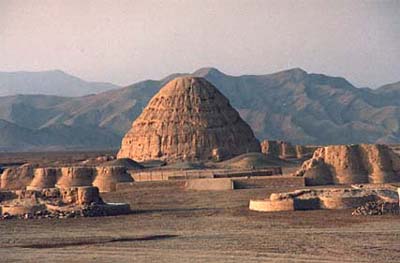 |
Western Xia Tombs,
one of the existing imperial Tombs, is the largest and the best
protected imperial cemeteries in china. It is also the most significance
national heritage and the mysterious ancient construction in Ningxia.
Of 119 scenic resorts and historic sites in China, Western Xia Tombs
is only one of scenic spot formed of separate imperial tomb.
The area of Western Xia Tombs covers more than 50 square kilometres,
4.5 square kilometres in breadth and 10 square kilometres in length.The
sites of the imperial mausoleums were chosen nearby at the east
foot of the Helan Mountains, 25 kilometers west of Yinchuan City.
The place were situated at an elevation between 1130 and 1200 metres.
The imperial tomb of a past ge,according to the document,is a separate
architectural structure, with battlements, archways, a stele pavilion,
outer and inner walls, a memorial hall, an altar, and other structures.
One imperial tomb, excavated in 1972, has a sloped passage way extending
about 150 feet underground to a area where a square coffin was placed.
A large number of objects (gold ornaments, jewelry, carvings, armor)
were found in the tomb. . |
 |
|
2,Chengtian Monastery Pagoda
The Chengtian Monastery Pagoda, also known
as "Western Pagoda", located at Xingqing District of
Yinchuan City, was built around A.D. 1050 when the Western Xia
was at the height of its ower and splendour. The Monastery Pagoda,
like Wuwei Huguo Temple and Zhangye Sleeping Buddha in Gansu Puovince
is a famous place for Buddhism in Western Xia period. It is 64.5
metres high with 13 storeys. At the eight corners of each storey
hangs small bells.Ningxia Museum is in the Monastery. It exhibits
many pieces of historical relics of Ningxia, cultural relics of
Hui Nationality and also some unearthed relics of Beizhou Dynasty.
|
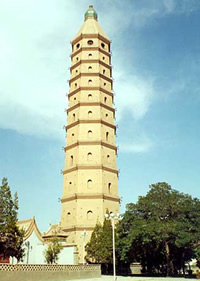 |
 |
3, Haibaoda Pagoda
Haibao Pagoda, also known as "Bei
Pagoda, Heibao Pagoda", Located in the northern suburb of Yinchuan.
Unique in style and exquisite in construction,it is a precious treasure
of ancient pagodas in China.
The pagoda has nine storeys -- eleven storeys if the base and pedestal
are included, and is 53.9 meters high. The pagoda is built on a
square brick base, each side measuring 19.7 meters long and 5.7
meters high. Its ground ichnography is cress-shaped, which is rare
in multi-storeyed pagodas. The first storey has a portico and an
arched door. Inside is an arhat niche flanked by brick steps leading
to the top of the pagoda. Arched doors on the front of each storey
are flanked by false niches. The interior of the pagoda is also
cross-shaped and in the center of each floor is a square chamber.
The pagoda tapers by fifteen to twenty centimeters from one storey
to the next. The steeple of the Haibao Pagoda is different from
that of other pagodas. It is peach-shaped and built of green glazed
bricks. |
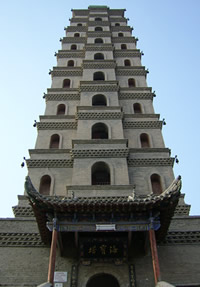 |
 |
|
4, Rock Paintings
The rock paintings discovered in
the Helan Mountains is a way of artful expression developed by
Chinese ancestors who painted and carved pictures and graphs in
rocks to record different aspects of ancient human society.
The rock Paintings in the Helan ountains feature many figures
with odd shapes and faces whereas the Xinjiang rock aintings have
many scenes of fertility worship. These pictures were carved on
grey or dark blue rock stones, in a simple and bold style."
|
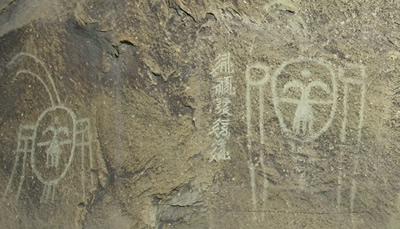 |
 |
|
5, 108 Pagoda
108 Pagodas, one of the existing
ancient grouped pagodas in china, is located in Qingtongxia
City in the dam area of the Yellow River, about 60 kilometers
south of Yinchuan. Leaning on mountains close to the waterside,
the pagodas are located on a precipitous slope sitting in the
west and facing east.
Arranged in twelve rows in the shape of a large equilateral triangle
-- tapering from one to nineteen, the pagoda complex is a cenotaph
for Buddhism with enduring mystery. All pure white in color contrasting
nicely with the golden desert, they are all brick Lamaist pagodas
with an octagonal Sumeru pedestal supporting the inverted-bowl-style
main body crowned with a bead, of which the pagoda at the tip
of the triangle on top of the slope is the biggest.
|
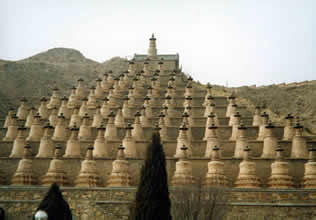 |
|